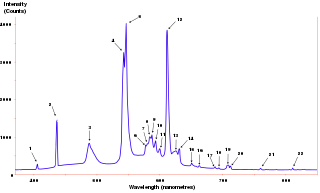
Complex analysis, traditionally known as the theory of functions of a complex variable, is the branch of mathematical analysis that investigates functions of complex numbers. It is useful in many branches of mathematics, including algebraic geometry, number theory, analytic combinatorics, applied mathematics; as well as in physics, including the branches of hydrodynamics, thermodynamics, and particularly quantum mechanics. By extension, use of complex analysis also has applications in engineering fields such as nuclear, aerospace, mechanical and electrical engineering.
In mathematics, a contraction mapping, or contraction or contractor, on a metric space (M,d) is a function f from M to itself, with the property that there is some nonnegative real number such that for all x and y in M,
In mathematics, the commutator gives an indication of the extent to which a certain binary operation fails to be commutative. There are different definitions used in group theory and ring theory.

The power spectrum of a time series describes the distribution of power into frequency components composing that signal. According to Fourier analysis, any physical signal can be decomposed into a number of discrete frequencies, or a spectrum of frequencies over a continuous range. The statistical average of a certain signal or sort of signal as analyzed in terms of its frequency content, is called its spectrum.
Fourier optics is the study of classical optics using Fourier transforms (FTs), in which the waveform being considered is regarded as made up of a combination, or superposition, of plane waves. It has some parallels to the Huygens–Fresnel principle, in which the wavefront is regarded as being made up of a combination of spherical wavefronts whose sum is the wavefront being studied. A key difference is that Fourier optics considers the plane waves to be natural modes of the propagation medium, as opposed to Huygens–Fresnel, where the spherical waves originate in the physical medium.
In mathematics, spectral theory is an inclusive term for theories extending the eigenvector and eigenvalue theory of a single square matrix to a much broader theory of the structure of operators in a variety of mathematical spaces. It is a result of studies of linear algebra and the solutions of systems of linear equations and their generalizations. The theory is connected to that of analytic functions because the spectral properties of an operator are related to analytic functions of the spectral parameter.
In mathematics, the Cayley transform, named after Arthur Cayley, is any of a cluster of related things. As originally described by Cayley (1846), the Cayley transform is a mapping between skew-symmetric matrices and special orthogonal matrices. The transform is a homography used in real analysis, complex analysis, and quaternionic analysis. In the theory of Hilbert spaces, the Cayley transform is a mapping between linear operators.

In geometry, a figure is chiral if it is not identical to its mirror image, or, more precisely, if it cannot be mapped to its mirror image by rotations and translations alone. An object that is not chiral is said to be achiral. In 3 dimensions, not all achiral objects have a mirror plane. For example, a 3-dimensional object with inversion centre as its only nontrivial symmetry operation is achiral but has no mirror plane.
In mathematics, the Veronese surface is an algebraic surface in five-dimensional projective space, and is realized by the Veronese embedding, the embedding of the projective plane given by the complete linear system of conics. It is named after Giuseppe Veronese (1854–1917). Its generalization to higher dimension is known as the Veronese variety.
In mathematics, a triangulated category is a category together with the additional structure of a "translation functor" and a class of "distinguished triangles". Prominent examples are the derived category of an abelian category and the stable homotopy category of spectra, both of which carry the structure of a triangulated category in a natural fashion. The distinguished triangles generate the long exact sequences of homology; they play a role akin to that of short exact sequences in abelian categories.
In mathematics, the Teichmüller space of a (real) topological surface , is a space that parametrizes complex structures on up to the action of homeomorphisms that are isotopic to the identity homeomorphism. Each point in may be regarded as an isomorphism class of "marked" Riemann surfaces, where a "marking" is an isotopy class of homeomorphisms from to itself.
In functional analysis, the dual norm is a measure of the "size" of each continuous linear functional defined on a normed vector space.

The mathematical concept of a Hilbert space, named after David Hilbert, generalizes the notion of Euclidean space. It extends the methods of vector algebra and calculus from the two-dimensional Euclidean plane and three-dimensional space to spaces with any finite or infinite number of dimensions. A Hilbert space is an abstract vector space possessing the structure of an inner product that allows length and angle to be measured. Furthermore, Hilbert spaces are complete: there are enough limits in the space to allow the techniques of calculus to be used.
In differential topology, the transversality theorem, also known as the Thom transversality theorem after French mathematician René Thom, is a major result that describes the transverse intersection properties of a smooth family of smooth maps. It says that transversality is a generic property: any smooth map , may be deformed by an arbitrary small amount into a map that is transverse to a given submanifold . Together with the Pontryagin–Thom construction, it is the technical heart of cobordism theory, and the starting point for surgery theory. The finite-dimensional version of the transversality theorem is also a very useful tool for establishing the genericity of a property which is dependent on a finite number of real parameters and which is expressible using a system of nonlinear equations. This can be extended to an infinite-dimensional parametrization using the infinite-dimensional version of the transversality theorem.
In functional analysis, a branch of mathematics, a strictly singular operator is a bounded linear operator between normed spaces which is not bounded below on any infinite-dimensional subspace.
In mathematics, the Earle–Hamilton fixed point theorem is a result in geometric function theory giving sufficient conditions for a holomorphic mapping of an open domain in a complex Banach space into itself to have a fixed point. The result was proved in 1968 by Clifford Earle and Richard S. Hamilton by showing that, with respect to the Carathéodory metric on the domain, the holomorphic mapping becomes a contraction mapping to which the Banach fixed-point theorem can be applied.

In functional analysis and related areas of mathematics, stereotype spaces are topological vector spaces defined by a special variant of reflexivity condition. They form a class of spaces with a series of remarkable properties, in particular, this class is very wide, it consists of spaces satisfying a natural condition of completeness, and it forms a *-autonomous category with the standard analytical tools for constructing new spaces, like taking dual spaces, spaces of operators, tensor products, and in addition, immediate subspaces, immediate quotient spaces, products and coproducts, limits and colimits, etc.
In algebraic topology, a G-spectrum is a spectrum with an action of a (finite) group.
This is a glossary of properties and concepts in algebraic topology in mathematics.







